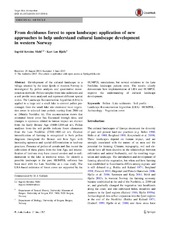From deciduous forest to open landscape: application of new approaches to help understand cultural landscape development in western Norway
Peer reviewed, Journal article
Published version

Åpne
Permanent lenke
https://hdl.handle.net/1956/10761Utgivelsesdato
2015-06-17Metadata
Vis full innførselSamlinger
Originalversjon
https://doi.org/10.1007/s00334-015-0539-6Sammendrag
Development of the cultural landscape in a village situated by the inner fjords of western Norway is investigated by pollen analysis and quantitative reconstruction methods. Pollen samples from lake sediments and a soil profile were analysed and represent different spatial scales. The Landscape Reconstruction Algorithm (LRA) is applied to a large and a small lake to convert pollen percentages from the small lake into estimated local vegetation cover in selected time periods starting from 2800 cal bc (Middle Neolithic A). This reconstruction shows that estimated forest cover has fluctuated through time, and changes in openness related to human impact are distinct from the Early Bronze Age (1800–1200 cal bc). Pollen analyses from the soil profile indicate forest clearances from the Late Neolithic (2300–1800 cal bc). Gradual intensification of farming is recognized in both pollen diagrams throughout the Bronze and Iron Ages with increasing openness and spatial differentiation in land-use practices. Presence of pollen of cereals and flax record the cultivation of these plants from the Iron Age, and intensification of land-use may have caused erosion and re-sedimentation in the lake in medieval times. To identify a possible landscape in the past, HUMPOL software has been used with the Late Neolithic as a case study. The LRA-based estimates of forest cover are supported by the HUMPOL simulations, but several solutions to the Late Neolithic landscape pattern exist. The results clearly demonstrate how implementation of LRA and HUMPOL improve the understanding of cultural landscape development.
